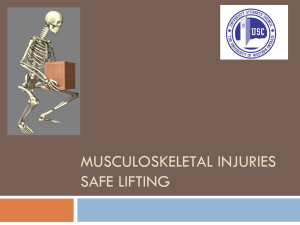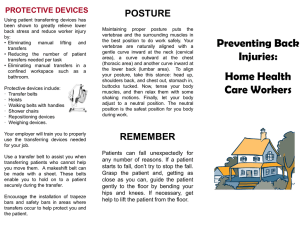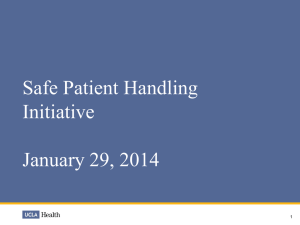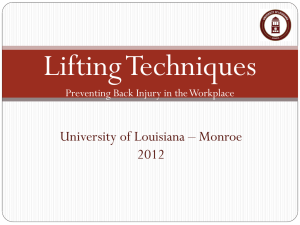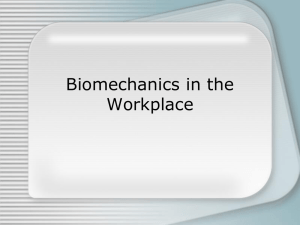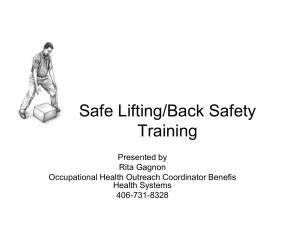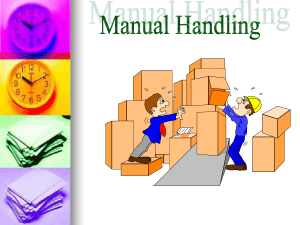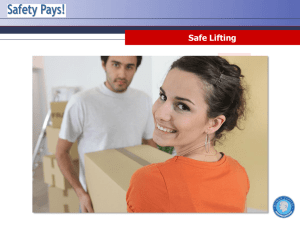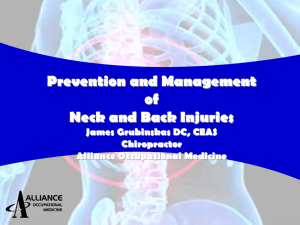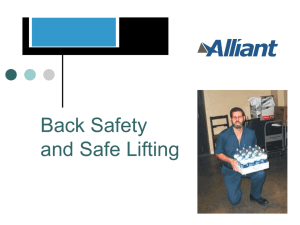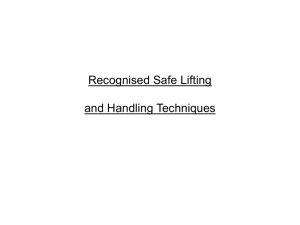Basics Presentation - City of Los Angeles Personnel Department
advertisement
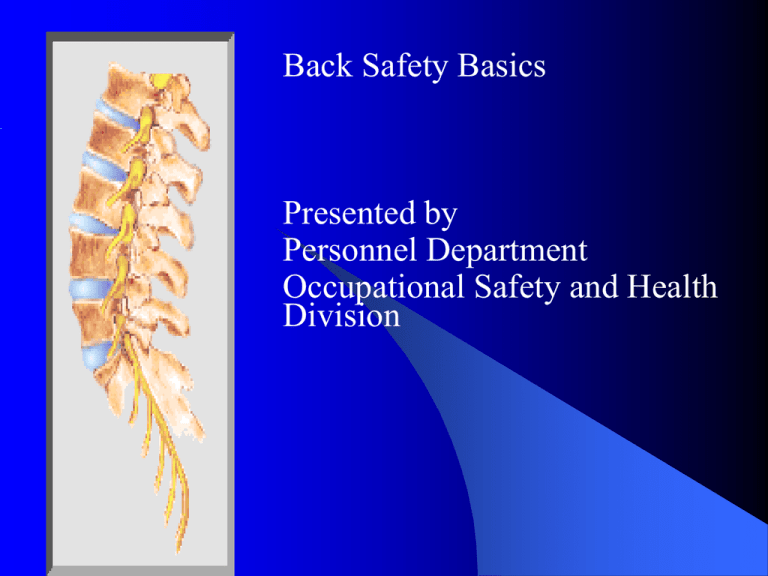
Back Safety Basics Presented by Personnel Department Occupational Safety and Health Division Prevent Back Injuries Which is better for your back—pushing an object or pulling an object? It is better to push an object, cart, dolly, lawnmower, wheelbarrow, etc. than it is to pull it. However, if you do have to pull it, consciously force yourself to tighten your stomach muscles and try to maintain good body posture. Back to Basics According to the Bureau of Labor Statistics: The part of the body most often affected by work injuries is the trunk (including the shoulder and back). –This accounts for 33 percent of all injuries and illnesses. These cases decreased by 4 percent from 2006. BLS-2007 data Back to Basics You will learn: – – – – How the spine works- Anatomy Factors Associated with Back Disorders Prevention and Control Lifting Techniques Back to Basics Imagine a stacked pile of jelly donuts, each on its own plate: The donuts are discs (nucleus & annulus) The plates are vertebrae The outer walls of the donut (annulus) keep the jelly inside to absorb shock and keep the plates from grinding together and breaking. Too much bending, twisting and lifting in awkward positions can wear away at the donuts crust- that can mean injury and pain “Back”ground Your Spine: – Supports your weight – Protects nerves that carry messages between your brain and body – Is flexible so allows you to move easily: Stretch Twist Bend Disks Vertebrae Nerves Muscles Ligament s “Back”ground Your Spine is made up of -24 movable back bones called Vertebrae -Nerves (spinal cord): they carry messages from your brain to the rest of your body ( e.g. organs) -Discs hold and cushion the vertebrae: Provide padding Absorb shock -Ligaments: bands of sturdy tissue (strong cable-like tissue) They mainly connect and hold the vertebrae in place -Muscles: attach to the vertebrae They provide stability,posture and flexibility Injuries-Why do they occur? The forces involved: • Think of your back as a lever. With the fulcrum in the center of the lever, how many pounds would it take to lift a 10 pound object? 5 pounds 10 pounds 15 pounds Why do they occur? You’re right! It takes 10 pounds of pressure to lift a 10 pound object. Will it take more or less force to lift the same 10 pound object with the fulcrum shifted to one side? Why do they occur? You’re right! With the fulcrum shifted away from the object, it takes more force to lift the object. The human back operates on a 10:1 ratio, with the waist acting as the fulcrum. Why do they occur? When you add in the 105 pounds of the average human upper torso, lifting a 10 pound object puts 1,150 pounds of pressure on the human back. Why do they occur? If you were 25 pounds overweight, it would put an additional 250 pounds of pressure on your back every time you bend over. Contributing Factors Back disorders result from 1.) Exceeding the capability of the muscles, tendons, discs. 2.) Cumulative effect of several contributors such as -Poor Posture ( how one sits or stands) -Stressful Living and working activities (static positions) -Bad body mechanics (lifting, pushing and pulling techniques) -Poor Physical condition: loss of strength and endurance -Poor design of job or work station -Repetitive lifting of awkward loads -Heavy lifting Signs and Symptoms Pain when attempting to assume normal posture, Decreased mobility Pain when standing or rising from a seated position. Other Contributing Factors These factors usually account for very few work-related back injuries. -Congenital defects of the spine -Increased in static standing and sitting tasks -An aging work force -Decrease in physical conditioning and exercise -Increased awareness of workplace hazards -Job dissatisfaction Other Contributing Factors The principal source of compensable injuries in the American work force is Manual Material Handling Approximately 4 out of 5 of these injuries will affect the lower back. Lifting Techniques Things to consider when approaching the load Get a firm footing Bend your knees Tighten Stomach muscles Lift with your legs Keep the load close to your body Keep your back upright Get help for heavy loads and Avoid awkward positions such as reaching and twisting while lifting. Prevent Back Injuries Also follow these lifting tips: • Reduce the amount of weight lifted. If you're moving a bunch of books, better to load several small boxes than one extremely heavy load. • Use handles and lifting straps. • Get help if the shape is too awkward or the object is too heavy for you to lift and move by yourself! Calling all Industrial Athletes You may not think you have much in common with professional athletes like Tiger Woods, Michael Jordan or Cal Ripkin, Jr. –but you do. Just like the pros, you depend on your body for your livelihood. Like the pros, you sometimes overdo it! *The consequences are: Lost time from work, you and your family suffer financial and emotional strain and last but not least LONG TERM PAIN Prevent Back Injuries Body Management: Stretch first – If you know that you're going to be doing work that might be hard on your back, take the time to stretch your muscles before starting, just like a professional athlete would do before a workout. This can help you avoid painful strains and sprains. Prevent Back Injuries Body Management: Slow down – If you're doing a lot of heavy, repetitive lifting, take it slowly if you can. Allow yourself more recovery time between lifts, as well. Don't overdo it. Prevent Back Injuries Body Management: Rest your back – Take frequent, short (micro) breaks. Stretch during these short breaks to relax the muscles and improve circulation. Finally, stretch briefly once the task is completed. It can help reduce next-day muscle soreness. Prevent Back Injuries Body Management: Sleep on a firm mattress – Also, the best sleeping position for many people is either on the back with the knees slightly elevated (by a pillow), or on the side with knees slightly bent (fetal position). Prevent Back Injuries Body Management: Get in shape – Strengthen your stomach muscles, lose a little weight, increase your flexibility. Proper condition can be the best prevention for back injury and strain. Summary Both management and workers have a role to prevent back injuries on the job. Management’s responsibility -Provide a safe and healthy workplace -Prevent known hazards -Implement effective injury prevention programs -Purchase and use lifting machines and devices -Conduct effective training and education programs -Provide proper medical care and treatment for injured workers Summary It is your responsibility to: - Work with your health and safety committee to prevent unsafe conditions - Listen to your body and report the first signs of back pain - Take care of your back and your health Where to Get More Information NIOSH Work Practice Guide for Manual Lifting Internet, City Intranet and Safety Bulletins Training Videos Your Department Safety Engineer The Personnel Department Health and Safety Division.
